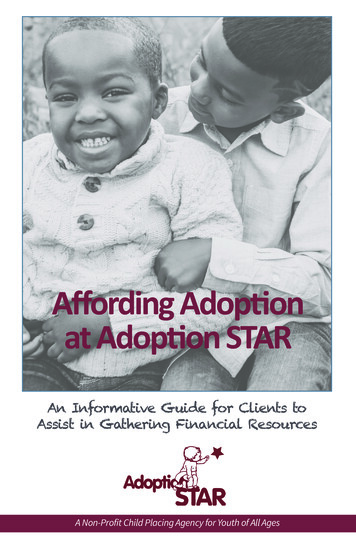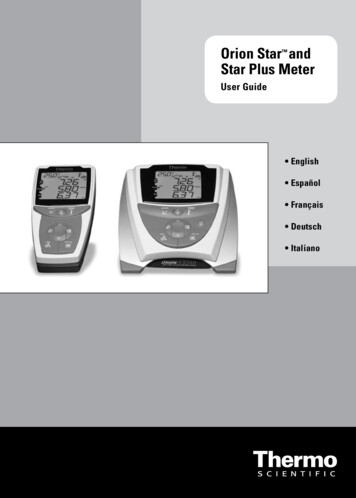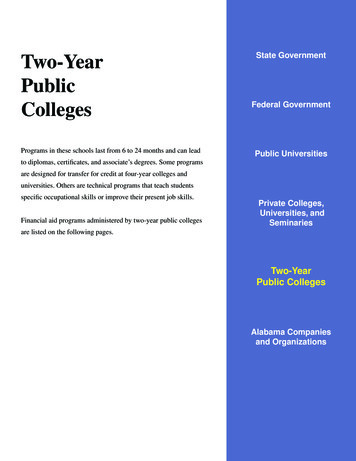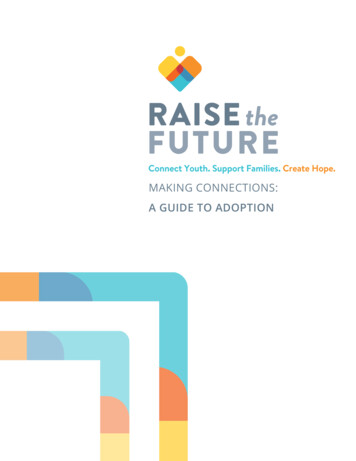
Transcription
Affording Adoptionat Adoption STARAn Informative Guide for Clients toAssist in Gathering Financial ResourcesA Non-Profit Child Placing Agency for Youth of All Ages
MAKING ADOPTIONAFFORDABLE:There are financial resources andprograms available to help you with youradoption costs with Adoption STAR!This informative booklet is provided to prospective adoptiveparents as they explore their adoption options. It is meant toassist you in learning that while adoption is not inexpensive, it ispossible.Adoption STAR is committed to making adoption affordable andbelieves fees should not be a barrier to finding a child a foreverfamily.We encourage you to discuss your personal financial situationwith us so we can guide you toward potential resources andoptions.Topics covered in this guide include:The Adoption STAR DifferenceAdoption STAR’s Sliding ScaleThe Federal Adoption Tax CreditState-Specific SubsidiesFederal Family and Medical Leave ActEmployee Benefit ProgramsAdoption Loans & Other Borrowing OptionsMilitary Non-Recurring SubsidyAdoption Grant ProgramsOther Resource PossibilitiesPage 2
THE ADOPTION STARDIFFERENCEAdoption STAR’s fee-based services provideclients with resources and support that addvalue to your adoption costs.Every adoption at our agency is enriched byadditional supports to ensure the wellbeing ofchildren and the cohesion of families. AdoptionSTAR’s staff offers expertise and support throughevery turn in the process, including:Personalized and Immediate Attention24/7 Access to SupportExtensive Adoption Education WorkshopsDesignated Family AdvocateDedicated Home Study Social WorkerIndividualized CounselingHome Study and Online Profiling AssistancePost Placement ServicesPeer Support and Special ProgramsPage 3
ADOPTION STAR’SSLIDING SCALEAdoption STAR is a nonprofit agency whosemission is finding homes for children in need.We are committed to providing quality services tochildren, birth parents, and adoptive parents. Toaccomplish our mission, we established a sliding scalefee for our services based on the applicant’s grossworth to enable as many families as possible to becomeadoptive parents and provide homes for children.The actual cost of providingservices far exceeds the revenuefrom your fees.Adoption STAR does not receive government funding-- we rely on fundraising, private donations, andfees for client services. Adoption STAR’s fees aretransparent and clearly outlined for all clients at thebeginning of the adoption process. Each fee schedule iscomprehensive for services that include: Domestic Infant AdoptionAgency-Assisted Private AdoptionAdopt an Older Kid (A-OK) ProgramInternational Adoption Home StudiesPost-Placement Support ServicesStep Parent Adoption ServicesKinship Adoption ServicesPage 4
MAKING ADOPTION AFFORDABLE:The Federal Adoption Tax CreditTInformation Provided Contains Direct Excerpts from theNorth American Council on Adoptable Children, https://www.nacac.orghe adoption tax credit is a nonrefundable credit, whichmeans it only offsets your federal income tax liability. Yourincome tax liability is the amount you are responsible for infederal income taxes for the year. The maximum federal taxcredit varies per year and can be found via irs.gov. The greatthing about this subsidy is that it is not a deduction that reducesyour income for purposes of determining your tax liability.Rather, it is a tax refund based on a dollar-for-dollar reduction ofyour total tax liability. Simply put, the adoption tax credit putsmoney back in your pocket to offset your adoption costs. You canalso predict a slight cost-of-living increase to the credit each yearbased on the IRS’s calculations.Am I Eligible to Claim the Adoption Tax Credit?You are eligible to claim the credit for adoption-relatedexpenses during the year they were incurred if: You adopted from the United StatesYou adopted internationally AFTER the adoption is finalizedYou adopted a child under age 18 from foster careYou adopted a stepchildYou adopted a relative’s childWill I Benefit From the Adoption Tax Credit?How much you will benefit from the credit depends on yourincome and federal income tax liability—which is the amountyou are responsible for in federal income taxes. Those who havelower incomes may not be able to use the credit and those withmoderate incomes often can’t use the whole amount.Page 5
People with no tax liability might not benefit from the adoptioncredit this year. If you can’t use all of the credit in the year youclaim it, you can carry the remainder forward for up to five moreyears to offset any of those years’ federal tax liability.What about in the Case of a SpecialNeeds Adoption?Whether an adoption is considered special needs does notaffect how much you will be able to benefit from the adoptiontax credit, though it will allow you to claim the full amount of thecredit even if you did not have any expenses. This doesn’t mean,however, that you will receive the full credit. Again, how muchyou can actually receive still depends on your income.What If the Adoption Is Unsuccessful?You can still claim the credit for expenses for a failed or nonfinalized adoption. The IRS allows you to treat these adoptionexpenses in the same manner as expenses you paid for adomestic adoption that was not finalized by the end of the year.For an international adoption, the adoption tax credit can beclaimed only if the adoption is successfully finalized.What Type of Proof Must I Submit toTake the Adoption Tax Credit?In order to take the adoption tax credit, you must completeForm 8839 for Qualified Adoption Expenses and be preparedto provide documentation to the IRS to prove your qualifiedadoption expenditures. Throughout the adoption process,you should keep all of your receipts, invoices, and financialdocuments relating to adoption so that you are prepared tosubmit this documents to the IRS during tax time.Page 6
MAKING ADOPTION AFFORDABLE:State-Specific SubsidiesSubsidies are provided to help meet the special needs of caring forhandicapped and hard-to-place children and to encourage andfacilitate their adoption. Subsidies help children who are no longer ableto remain with their birth family gain a warm and supportive family.New YorkIn New York, Adoption subsidies are available for handicappedand hard-to-place children who are in the custody andguardianship of the local commissioner of social services, or anauthorized voluntary agency in New York State, or a certified orapproved foster parent. Not every child in the guardianship andcustody of a commissioner or a voluntary agency in New YorkState is eligible for a subsidy. Eligibility for adoption subsidies isbased on federal and state statutes and regulations. Eligibilitydetermination requires verification that the child meetsregulatory standards as supported by provision and approval ofrequired documentation. Rates for maintenance payments aregenerally based on severity of child need. For an adoption subsidyto be approved, the child need must fall within the rate categoryestablished by each social service district. Documentation thatrequirements for rate eligibility are satisfied must be provided.(Information provided by NYS Office of Children and FamilyServices; al (Title IV-E) and Florida state (often called non-IV-E)adoption assistance programs are designed to help parentsmeet their adopted children’s varied, and often costly, needs.Children can qualify for federal adoption assistance or stateassistance, depending on the child’s history. Adoption subsidypolicies and practices are, for the most part, dependent on thePage 7
state in which the child was in foster care before the adoption.Florida categorizes “special needs” as a child who:1. Was permanently committed to the Florida Department ofChildren and Families or a licensed child placing agency - AND 2. Has significant emotional ties to his or her foster parent or hasat least one of the following needs or circumstances that may be abarrier to adoption: Eight years of age or olderAfrican American or racially-mixed parentageMember of a sibling group being placed for adoption as a unitDevelopmentally disabledPhysically or emotionally disabled - AND -3. There were reasonable but unsuccessful efforts to place withoutadoption assistance. (Information provided by the North AmericanCouncil on Adoptable Children; https://www.nacac.org).OhioThe public children services agency (PCSA) must make the specialneeds determination for adoption assistance eligibility beforeadoption finalization. The PCSA must determine that:1. The child cannot or should not be returned home to his or herparent(s).2. Reasonable, but unsuccessful, efforts have been made to placethe child without adoption assistance. There are exceptions whenit is contrary to the best interest of the child.If the child meets both criteria above, then the PCSA shalldetermine if the child has one or more of the following factors orconditions that make it difficult to place the child without adoptionassistance or medical assistance:Page 8
Ohio, Continued The child is six years of age or older. The child is at least one year old and is a member of aminority racial or ethnic group that makes it difficult toplace the child for adoption. The child is part of a sibling group being adopted togetheror is being placed in the same adoptive placement of asibling previously adopted. A qualified professional has diagnosed the child with adevelopmental disability, developmental delay, mentalillness, or medical condition. The child has been in the permanent custody of a PCSA orprivate child-placing agency (PCPA) for more than one yearbefore an adoptive placement. The child experienced a previous adoption disruption ormultiple placements while in the custody of a PCSA orPCPA. The child has been placed in foster care in the homeof his or her prospective adoptive parent(s) for at leastsix consecutive months directly preceding the adoptiveplacement, and the child would experience severeseparation and loss if placed in another setting due to his orher significant emotional ties with these foster parent(s) asdocumented by a qualified mental health professional. The child has a social or medical history or the biologicalfamily’s social or medical history that may place the child atrisk of acquiring a medical condition, a physical, mental ordevelopmental disability, or an emotional disorder.(Information provided by https://www.nacac.org)Page 9
MAKING ADOPTION AFFORDABLE:Federal Family & Medical Leave ActIn addition to the federal adoption tax credit and state-specificadoption subsidies, adoptive families may benefit from the federalFamily and Medical Leave Act (or FMLA).While the FMLA does not provide direct cash support, it cansafeguard against the loss of employment following an adoptionas parents take time to care and bond with a child. This act allowsindividuals to take up to 12 weeks unpaid leave, with certainbenefits, without jeopardizing employment. This is particularlyvaluable in the instance of an out-of-state placement where manyadoptive parents are required to stay in the state where their childis born for an average of 7 to 10 business days to comply withthe Interstate Compact on the Placement of Children (ICPC). Thisextra time allows parents to meet these placement requirementswithout fearing the loss of employment while their family grows.This is not exclusive to an adoption – this benefit is available foranyone who works for a company with 50 or more employees.The FMLA recognizes adoption maternity leave just as they wouldfor a pregnant employee and this ensures that you get to enjoyyour first weeks with your child at home.Employee Benefits ProgramsMany adoption-friendly companies offer some type of adoptionbenefits to their full-time, permanent employees. These benefits,depending on your company, may include direct reimbursementin the range of 2,000 to 10,000 upon placement; paid leave inaddition to vacation time, sick leave or personal days; or unpaidpersonal, medical, or childcare leave. Wonder if your employeris nationally-recognized as a adoption-friendly workplace?Interested in exploring ways your workplace can provide adoptionbenefits? Visit the Dave Thomas Foundation to learn more: adoption-friendlyworkplace/.Page 10
MAKING ADOPTION AFFORDABLE:Adoption Loans & Other Borrowing OptionsWhile it’s far from ideal to borrow money to offset the immediate costof adoption, prospective adoptive families may find a loan necessary.While borrowing money to offset the cost of an adoption isnot ideal, adoptive families may find it necessary to take out aloan to cover some or all of their adoption-related expenses.By maximizing the federal adoption tax credit and/or adoptionreimbursements from an employer (where available), adoptivefamilies may be able to pay back their adoption loans quickly.The decision to offset the cost of an adoption with loans is not aneasy one and requires serious consideration about your family’sfinancial wellbeing. It is important to weigh risk and return withany big financial decision, especially in the case of dipping intoretirement savings or running up credit card debt that maychange your long-term financial goals or add additional stressorsto an already significant life change.We encourage you to weigh your options and consider speakingwith a financial advisor or other professional to better assess yourfamily’s financial situation and future.Loan options for adoptive families might include:Home Equity Loans: Borrowing against the equity of your home(using your property as collateral) is one option. A low-interesthome equity loan can help you access funds to offset the cost ofyour adoption using the value of your property as determined byan appraiser from your chosen lending institution.Borrowing Against An Insurance Policy: Whole life insurance, ascalled permanent life insurance, offers a death benefit that alsobuilds cash value you can borrow against. Whole life insurancePage 11
can protect your family in the event of your death, but can alsoserve as a financial resource as you may be able to borrow againstits cash value to cover large expenses.Low- and No-Interest Adoption Loan Programs: Some banks andother private (and often religious) entities offer unsecured low- orno-interest loans or credit lines for adoptive parents. With marketofferings changing day-to-day, consider addition “adoption loans”to your Internet searches and exploring available options thatmight suit your needs. Consumers beware! Make sure any lenderyou select is reputable and well established.Borrowing from Relatives: Family and finances can be acomplicated mix, but relatives who follow you on your adoptionjourney – and personally understand your wish to parent throughadoption – might be a source of financial support. Also considerusing an online fundraising platform (such as GoFundMe orYouCaring) to set up a family fundraiser where friends and lovedones can donate toward your adoption goal.Credit Cards: Credit cards are, typically, a more readily accessiblesource of cash, but typically come with higher interest rates dueto the short-term nature of the credit. Most financial plannerswould warn against tapping into these sources unless absolutelyessential. Families might choose to pay for smaller costs (such ashome studies or online profiles) using a credit card and pay forlarger placement costs with a different “pot” of money.Retirement Accounts: 401(k)s and profit-sharing retirementplans usually offer lower interest rates than credit cards, butif you change or lose your job and cannot repay the loanquickly, it will become a taxable withdrawal. In addition tothe income taxes you’ll have to pay on the withdrawal, youwill also pay a percentage penalty if you are younger than59.5 years of age. As is the case with using credit cards topay for adoption expenses, most financial planners will warnagainst tapping into retirement accounts unless necessary.Page 12
MAKING ADOPTION AFFORDABLE:Military Non-Recurring SubsidyThe military will reimburse active-duty personnel up to 2,000 inadoption expenses per Department of Defense (DoD) directives.Reimbursement is made after the adoption is finalized and if theadoption is completed through a licensed agency, like AdoptionSTAR. Eligible personnel should complete the ReimbursementRequest for Adoption Expenses Form 2675 (please check toensure the most current form available as the number maychange) and refer to DoD Finance and Accounting ServiceInstruction 1341.09 for more information. Additional details canbe found by visiting www.militaryfamily.org.MAKING ADOPTION AFFORDABLE:Adoption GrantsFunding a portion or the majority of your adoption expenses ispossible through local and national grantmaking. Grant money isFREE money, and free money is the BEST money!Adoption STAR offers two mini grants to help assist prospectivefamilies in two areas (visit adoptionstar.com for full details): Shining STAR is a grant program to help defray the costs ofadopting a child identified as having special needs. Support for LGBTQ Families offers financial support forqualified candidates as part of Adoption STAR’s commitment toaffirming services and access for all types of families.HelpUsAdopt.org is a national non-profit financial assistancegrant program that will provide qualified couples and individuals(regardless of race, religion, marital status or sexual orientation)with grants of up to 15,000 towards their adoption expenses.Page 13
National Adoption Foundation is dedicated to providing financialsupport for adoptive families in order to assist them in thesuccessful adoption of children. We are committed to improvingeach child’s chance of becoming part of a loving family. TheFoundation’s programs are available to any family whether they areadopting a child domestically, abroad or from foster care. Visit themonline at www.fundyouradoption.org.A Child Awaits offers both grants of up to 7,000 to U.S. citizensadopting internationally, as well as low-interest loans for familieswith less than 150,000 in combined household income. Grantapplications are accepted year-round. Visit www.achildawaits.orgfor eligibility and giving guidelines.Gift of Adoption Fund applications are accepted from any U.S.family with an approved and current home study from a licensedand accredited adoption agency. Financial need and personalcommitment to funding and completing the adoption must bedemonstrated by all applicants. Visit www.giftofadoption.org tolearn more.Parenthood for Me, a local Western New York funder, offersgrants and emotional support to couples who have struggled withinfertility who have chosen the path of adoption to build theirfamilies. Visit http://parenthoodforme.org/grants.php.The Boatner Family Foundation provides grants ranging from 1,000 up to nearly 13,000 and requires that adoptive familieshave received approval from their agency. Contact: The BoatnerFoundation, P.O. Box 132272, The Woodlands, Texas 77393-2272.Religious Organizations: Many churches and other religiousorganizations have embraced adoption as part of their religiousmission. Find out if your place of worship offers grant (or evenlow-interest loan) funds for families pursuing adoption. There are anumber of faith-based grantmaking entities, including Pathways forLittle Feet, Show Hope, ABBA Fund, and Hebrew Loan Association.Page 14
Notes
NYS Authorized, FL & OH LicensedNew York Office131 John Muir DriveAmherst, NY 14228Phone: 716-639-3900Florida Office1040 Bayview Drive, Suite 318Fort Lauderdale, FL 33304Phone: 954-566-6055Ohio Office18 W. 9th Street, Suite 100Cincinnati, OH 45202Phone: 513-631-3900Other Ways to Contact Us:Albany: 518-391-2515Binghamton: 607-330-2158Rochester: 585-672-5227New York City: 917-470-9340Syracuse: 315-703-7511Poughkeepsie: 845-457-4883Cleveland: 216-201-9177Miami: 305-433-8531Toll Free: 866-691-3300ADOPTIONSTAR.COM
The FMLA recognizes adoption maternity leave just as they would for a pregnant employee and this ensures that you get to enjoy your first weeks with your child at home. Employee Benefits Programs. Many adoption-friendly companies offer some type of adoption benefits to their full-time, permanent employees. These benefits,










